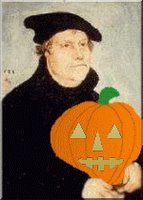 The Thirty-first of October is the Eve of All Saints, also known as All Hallows' Eve or Halloween. That means that the following day must be All Saints' Day (a remembrance of the martyrs and saints). The time of year was chosen in part to counter pagan festivals which focused on spiritism or witchcraft. These were common in much of Europe as non-Christians watched the lengthening of the night and the loss of daylight.
The Thirty-first of October is the Eve of All Saints, also known as All Hallows' Eve or Halloween. That means that the following day must be All Saints' Day (a remembrance of the martyrs and saints). The time of year was chosen in part to counter pagan festivals which focused on spiritism or witchcraft. These were common in much of Europe as non-Christians watched the lengthening of the night and the loss of daylight.Much of the costuming and carousing on Halloween may have roots in the practices of bygone ages, when Christians would mock Satan, to show that he had no power over Christ's Church. This mockery goes along with the thinking of Martin Luther, who had no doubts about Satan's existence but knew him as a strong enemy, yet one already defeated by Christ. He said of music, "I have no pleasure in any man who despises music. It is no invention of ours: it is a gift of God. I place it next to theology. Satan hates music: he knows how it drives the evil spirit out of us." Luther then also lauded laughter: "I often laugh at Satan, and there is nothing that makes him so angry as when I attack him to his face, and tell him that through God I am more than a match for him."
This gives us a nice segue into thoughts on the beginnings of the Evangelical (Gospel) movement, Lutheranism, and the Reformation: The Eve of All Saints is more than a night of extorting candy from our neighbor under threat of dire tricks. We Lutherans celebrate All Hallows' Eve as Reformation Day.
We remember the Reformation's earliest hours with Martin Luther posting debate topics concerning abuses in Roman Catholicism on a church door. We ponder the spread of the Lutheran Reformation throughout Europe. In its wake, Roman Catholic domination of the continent crumbled, changing political and social boundaries. Most non-Roman Catholic churches in the West owe at least part of their existence to the Reformation or its aftermath.
Reformation Day is thus celebrated every 31 October as Lutherans mark the anniversary the 1517 posting of the Ninety-five Theses on a church door in Wittenberg, Saxony. While there had been divisions among Christ's followers from the time of Jesus' earthly life onward (see, for example, the conclusion of John 6), the Reformation marked one of the two great divisions in the Church. The other was the split between the eastern (Orthodox) and the western (Roman Catholic) churches.
 While the first split still kept both sides relatively intact, the Reformation's aftermath more completely dissolved earthly unity. This was in part because of the times in which it came, with increasing nationalism and free-thinking stemming from the Renaissance. The Lutheran party was ejected from the Roman Catholic Church; others who disagreed with Rome but who did not agree with Luther joined the Lutherans for a time. Later, some of these would splinter off into other bodies. England, which was protected by water from threats of force, went its own way from the beginning. Yet the English (Anglican) Reformation also was divided for both doctrinal and political reasons.
While the first split still kept both sides relatively intact, the Reformation's aftermath more completely dissolved earthly unity. This was in part because of the times in which it came, with increasing nationalism and free-thinking stemming from the Renaissance. The Lutheran party was ejected from the Roman Catholic Church; others who disagreed with Rome but who did not agree with Luther joined the Lutherans for a time. Later, some of these would splinter off into other bodies. England, which was protected by water from threats of force, went its own way from the beginning. Yet the English (Anglican) Reformation also was divided for both doctrinal and political reasons.Since it started with Luther — who built on the work of earlier theologians and reformers — the Lutheran Church has celebrated the day with more zeal than most. This can be positive, reminding us of the core reason why it all happened. Martin Luther was convinced that the saving Gospel of Jesus Christ was being obscured by legalism and empty, unchristian ceremonialism. Thus, when Christians gather to receive and rejoice in salvation by grace through faith in Christ, such celebrations are good.
However, when Lutherans or others use the day as one of empty boasting, of vainly over-trumpeting Luther, other reformers, and their followers, or by attacking and criticizing others save over important matters of doctrine and practice, they risk returning to the bondage of legalism that the Reformation sought to cast off. Likewise, well-meaning but misguided heirs to Luther do great harm when they throw out good ceremonies and traditions that the reformers kept, just because they think of them as being "too old-fashioned" or "too Catholic."
The heirs of the Gospel also place themselves back under God's law if they judge intent in others or if they take false pride in their heritage instead of holding true pride in the merits of Christ. They also create problems when they attack what is good in what other churches have kept simply because they disagree with part of what those churches teach.
Concerning today's illustration, a brother pastor in my circuit noted that Luther gets the credit for the widespread popularity of the Christmas tree. He figures that with this picture we might also be able to promote a folk belief that he introduced the Halloween jack-o'-lantern. This could have the collateral benefit of providing our church youth groups with a new source of income, October pumpkin sales.
Lection
Psalm 46
Isaiah 55:1-11 or Jeremiah 31:31-34
Revelation 14:6-7 or Romans 3:19-28
Matthew 11:12-15 or John 8:31-36
Collect
Almighty God, gracious Lord, pour out Your Holy Spirit on Your faithful people. Keep them steadfast in Your grace and truth, protect and comfot them in all temptations, defend them against all enemies of Your Word, and bestow on the Church Your saving peace; through Jesus Christ, Your Son, our Lord, who lives and reigns with You and the Holy Spirit, one God, now and forever.
Technorati Tags: Reformation Day | All Saint's Eve | All Hallow's Eve | Martin Luther | Lutheran Reformation | Lutheran | Christian | Wittenberg | Gospel | Evangelical | historical theology | church history
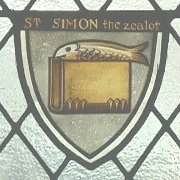 On the various New Testament lists of the Twelve Apostles (Matthew 10:2-4; Mark 3:16-19; Luke 6:14-16; Acts 1:13), the tenth and eleventh places are occupied by Simon the Zealot (also called Simon the "Cananean," the Aramaic word meaning "Zealot") and by Judas of James, also called Thaddaeus or Lebbaeus.
On the various New Testament lists of the Twelve Apostles (Matthew 10:2-4; Mark 3:16-19; Luke 6:14-16; Acts 1:13), the tenth and eleventh places are occupied by Simon the Zealot (also called Simon the "Cananean," the Aramaic word meaning "Zealot") and by Judas of James, also called Thaddaeus or Lebbaeus.Simon is not mentioned by name in the New Testament except on these lists. If he was of the Jewish religio-political organization known as the Zealots, he would have been part of an effort to overthrow Roman rule. However, the title might only be descriptive of his personality.
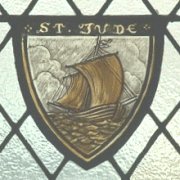 Judas (often called Jude in English) is variously named, but this is not surprising. Before the Crucifixion, there would be a need to distinguish him among the apostles from Judas Iscariot, and after the Crucifixion there would be an additional reason for being emphatic about the distinction.
Judas (often called Jude in English) is variously named, but this is not surprising. Before the Crucifixion, there would be a need to distinguish him among the apostles from Judas Iscariot, and after the Crucifixion there would be an additional reason for being emphatic about the distinction.After the Last Supper it was Jude who asked Our Lord why he chose to reveal Himself only to the disciples. He received the reply: "If anyone loves me, he will keep my word, and my Father will love him, and we will come to him and make our home with him. (see John 14:22-31)"
Lection
Psalm 119:89-96 or 119:73-80
Deuteronomy 32:1-4 or Jeremiah 26:1-16
1 Peter 1:3-9 or 1 John 4:1-6
John 15:17-21 or 14:21-27
Collect
O almighty God, whose Church is built on the foundation of the apostles and prophets, Jesus Christ Himself being the chief Cornerstone, grant us to be joined together in unity of spirit by their doctrine that we may be made a holy temple acceptable in Your sight; through Jesus Christ, Your Son, our Lore, who lives and reigns with You and the Holy Spirit, one God, now and forever.
Technorati Tags: Saint Simon | Saint Jude | Thaddaeus | Lebbaeus | St. Simon | St. Jude | Saint Judas | St. Judas | Simon the Zealot | Judas Iscariot | Jesus Christ | Jesus | Christ | apostles | disciples | biblical history | New Testament | church history | Christianity
Philipp Nicolai: 26 October AD 1608
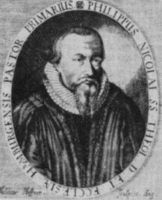 Nicolai was born in Waldeck, Germany 10 August 1556, the son of a Lutheran pastor. He entered the University of Erfurt and in 1576 he went to Wittenberg. For four years after his graduation, he lived at Volkhardinghousen and frequently preached for his father. In 1583, he was appointed Lutheran preacher at Herdecke, but because of a Roman Catholic town council, he found many difficulties there Following an invasion by Spanish troops in April 1586, a colleague re-introduced the Mass and Nicolai resigned his call.
Nicolai was born in Waldeck, Germany 10 August 1556, the son of a Lutheran pastor. He entered the University of Erfurt and in 1576 he went to Wittenberg. For four years after his graduation, he lived at Volkhardinghousen and frequently preached for his father. In 1583, he was appointed Lutheran preacher at Herdecke, but because of a Roman Catholic town council, he found many difficulties there Following an invasion by Spanish troops in April 1586, a colleague re-introduced the Mass and Nicolai resigned his call.In the end of 1586 he was appointed diaconus at Niederwildungen, near Waldeck and became pastor in 1587. In November 1588, he became chief pastor at Altwildungen, court preacher to the widowed Countess Margaretha of Waldeck, and tutor to her son, Count Wilhelm Ernst. He found himself in disagreement with Calvinists on the meaning of the Lord's Supper and worked toward having principality's clergy adopt the Formula of Concord.
He went to Unna in Westphalia in 1596 which led to more controversy with the Calvinists. Unna fell victim to the plague in 1597 and 1598, which took the lives of 1,300 of its inhabitants. From the parsonage which overlooked the churchyard, Nicolai was saddened by the continual burials. On one day thirty graves were dug. In the midst of this distress he wrote a series of meditations which he titled, Freuden Spiegel ("Mirror of Joy"). These writings Nicolai look to the hope of eternal life in Christ. On 27 December 1598, Nicolai fled before the invasion of the Spaniards, not returning until the end of April 1599. During this time Nicolai prepared his Frewden-Spiegel dess ewigen Lebens ("Joyful Mirror of the Eternal Life.")
In April 1601, he was elected chief pastor of Saint Katherine's Church, Hamburg, beginning his duties on 6 August. Life passed without many recorded incidents until 22 October 1608, when he participated in an ordination and returned home feeling ill. He developed a violent fever, dying 26 October 1608.
While in Hamburg, Nicolai gained fame for his preaching, often hailed as a "second Chrysostom." Still, we remember him most for his hymns. Of them, only four seem to have been published. These "Jesus hymns" began a new era of hymn writing in the 17th Century. Published only a few years before Johann Arndt's True Christianity, they show a similar devotional feeling toward Jesus.
Johann Heermann: 17 February AD 1647
 Johann Heermann, considered the greatest Lutheran chorale writer between Luther and Gerhardt, was influenced by Valerius Herberger, writer of the hymn, Valet will ich dir geben. Heermann was born in Silesia, studied in Leipzig, Jena, and Strasbourg, and was called to be pastor in Köben in 1611. He contracted tuberculosis in 1634 and resigned his pastorate in 1638 because of declining health. He moved from there to Lissa, Poland, dying nine years later.
Johann Heermann, considered the greatest Lutheran chorale writer between Luther and Gerhardt, was influenced by Valerius Herberger, writer of the hymn, Valet will ich dir geben. Heermann was born in Silesia, studied in Leipzig, Jena, and Strasbourg, and was called to be pastor in Köben in 1611. He contracted tuberculosis in 1634 and resigned his pastorate in 1638 because of declining health. He moved from there to Lissa, Poland, dying nine years later.Many of Heermann's hymns were written for family devotions, so much of his output was based on Johann Arndt's Paradies Gärtlein ("Garden of Paradise"). His life was filled with suffering and sadness. During the Thirty Years War, he lost everything he owned three times. His first wife died young, he developed chronic sinusitis and bronchitis, rendering him unable to speak any length without terrible coughing. In spite of this, he helped his parishoners deal with their own difficulties as they, along with him, lost everything in war, pestilence and plague. After moving to Poland on the advice of his doctor son-in-law, he was built a small home. However, his sufferings overwhelmed him more and more. By the end of his life, he could neither sit or lie down, and slept while leaning against a wall.
In spite of his afflictions, he continued writing hymns of praise and comfort. Many consider his famous "Ah! Holy Jesus" to be among the finest of all passion hymns. His writing, rooted in the Jesus mysticism of the Middle Ages, is thought to have been one of the sources for the Pietist movement.
Paul Gerhardt: 27 May AD 1676
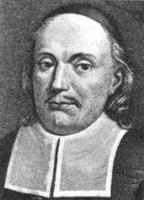 Paul Gerhardt was dubbed the "sweet singer of Lutheranism." He was born on 12 March 1607 in Gräfenhaim, near Wittenberg and lived during the religious wars of the 17th century. He received training as a Lutheran pastor at Wittenberg, where Martin Luther had taught a century before. However, Gerhardt didn't receive a call to a church until 1651, when he was ordained to serve the congregation in Mittenwalde, southeast of Berlin.
Paul Gerhardt was dubbed the "sweet singer of Lutheranism." He was born on 12 March 1607 in Gräfenhaim, near Wittenberg and lived during the religious wars of the 17th century. He received training as a Lutheran pastor at Wittenberg, where Martin Luther had taught a century before. However, Gerhardt didn't receive a call to a church until 1651, when he was ordained to serve the congregation in Mittenwalde, southeast of Berlin.While awaiting a call, he taught the children of Andreas Barthold — one of whom, Anna Maria, he later married. During that time he met Johann Crüger, the kantor and organist of Saint Nicholas Church, Berlin. Together they produced some of the greatest Lutheran chorales, including "Awake, My Heart with Gladness," (Auf, auf, mein Herz), "Now All the Woods Are Sleeping," and "All My Heart this Night Rejoices," among others.
Gerhardt's hymns combine a strong, objective faith in justification as a free gift from God with his own warm, subjective experience of that gift. In all, he wrote more than 120 hymns, many of which are still known and loved throughout the world.
His life, however, was difficult. He suffered greatly because of the religious wars. When asked to refrain from preaching against Calvinism by Elector Friedrich Wilhelm of Prussia, conscience would not allow him to compromise his Lutheran beliefs. He was soon deposed from office and barred from holding services even in his own home. During this time his wife and one son died, leaving him alone with a boy of six.
In May 1669, the congregation in Lübben, near the southeastern border of Germany, called him as pastor. He served there until his death on 27 May 1676. The Lübben congregation commissioned a life-sized painting of him for the church and in 1930, following renovation, the church was renamed Paul-Gerhardt-Kirche in his honor. The painting still hangs there. Beneath it is inscribed a fitting epitaph: "A theologian sifted in Satan's sieve."
Lection
Psalm 40
Deuteronomy 31:30-32:47
Colossians 3:12-17
John 16:16-24
Collect
Almighty God, through your holy apostle You taught us to praise You in psalms and hymns and spiritual songs; we give You thanks this day for the gift of hymn writing which confesses the Faith and inspires the faithful which You gave to Your servants Philipp Nicolai, Johann Heermann, and Paul Gerhardt, and we pray that Christ's Church may never lack those with the gifts of writing words and music to Your praise. May the Church be ever filled with the desire to praise and thank You for your grace, mercy, and faithfulness; through Jesus Christ, Your Son, our Lord, who lives and reigns with You and the Holy Spirit, one God, now and forever.
Technorati Tags: Lutheran | hymns | chorales | church music | Philipp Nicolai | Johann Heermann | Paul Gerhard | Martin Luther | Johann Arndt | Pietism | confessional Lutheranism | hymn writer | hymnody
Sorry to anyone who got a password request when logging on to either the Alley or Luther Library. One of the feed aggregators started asking for a password in order to retrieve its graphical blog button. The button and its offending host have been deleted and there is joy in Aardvark Land.
I read a post about the Ms Magazine story of women who named themselves as having had an abortion. The author cited an AP story from AOL News — a story that included a brief poll. Being curious about the issue itself and wondering how people had responded, I followed the link, read the news item, took the survey, and read the results.
Then I noticed the ad that sat beside the photo of Eleanor Smeal and decided that the juxtaposition was too ironic, bizarre, or just plain yucky to not share. Since AOL rotates its ads, so I took this screen shot (clipped but unretouched) so it wouldn't get away:

Wouldn't it be nice if we could take a pill to ward off abortion promoters as easily as Novartis claims we can evict Digger the Dermatophyte™ from our nails?
Technorati Tags: pro-life | Ms Magazine | Eleanor Smeal | Feminist Majority Foundation | toe nail fungus | nail fungus | Lamisil® | Lamasil | Digger the Dermatophyte™ | list of women who had an abortion | abortion | irony | sarcasm | humor
As noted in a previous post with the video clip against the cloning initiative, we face a daunting task in saying "NO" to any political initiative — especially one so cunningly crafted as Missouri Amendment Two. When Michael J. Fox begs for sympathy votes, because of his Parkinson's disease, the pro-life (but anti-2) crowd can look like a bunch of heartless ogres who just don't understand the needs of those suffering from the afflictions this initiative purports to be able to address. The same happens when Nancy Reagan talks about Ronald's Alzheimer's, Christopher Reeve's widow brings up spinal cord injuries, Cheryl Crow mentions cancer, or Senator John Danforth talks about his brother's ALS. Using the vernacular, healthy pro-lifers "ain't got a dog in that fight."
With these in mind, I commend to your reading a letter from a retired pastor of The Lutheran Church — Missouri Synod. He lives in the state and has much more than a spectator's interest. While confessing his own spiritual weaknesses and the allure that Two provides, he also says, "I'm voting no on Amendment 2. Isn't everyone? We even have the sign in our yard." Read the entire letter about having A Dog in the Fight courtesy of Ask the Pastor.
Technorati Tags: embryonic stem cells | cloning | Missouri | Amendment 2 | Lutheran | Christian | pro-life | Parkinson's Disease | ALS | Amyotrophic Lateral Sclerosis | Lou Gehrig's Disease | Alzheimer's Disease | Michael J. Fox | Senator Danforth | John Danforth | Ronald Reagan | Nancy Reagan | Christopher Reeve | Cheryl Crow | Embryonic Stem Cell Research | ESCR
These women were exemplary Christians who demonstrated their faith by their material support of the Church.
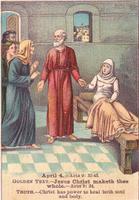 Dorcas (or "Tabitha," both names meaning "gazelle") was well-known and much loved for her acts of charity in the city of Joppa, especially for her making clothes for the poor. When Dorcas died suddenly, the members of her congregation sent to the neighboring city of Lydda for the Apostle Peter, who came and raised her from the dead (Acts 9:36-43).
Dorcas (or "Tabitha," both names meaning "gazelle") was well-known and much loved for her acts of charity in the city of Joppa, especially for her making clothes for the poor. When Dorcas died suddenly, the members of her congregation sent to the neighboring city of Lydda for the Apostle Peter, who came and raised her from the dead (Acts 9:36-43).Lydia was a woman of Thyatira, who worked at Philippi selling a famous purple dye that was so much in demand in the ancient world. She was also a "worshiper of God," most likely at a local synagogue. When the Apostle Paul encountered her in prayer among other proselyte women, his preaching of the Word brought Lydia to faith in Christ. She and her friends thus became the nucleus of the Christian community in Philippi (16:11-15). It was to her house that Paul and Silas returned following the conversion of the Philippian jailer (16:16-40).
Phoebe was another faithful woman associated with the Apostle Paul. She was a church servant (perhaps "deaconess") from Cenchrae (the port of Corinth) whom Paul sent to the church in Rome with his Epistle to the Romans. In it he writes of her support for the work of the early Church (Romans 16:1-2).
All of these women continue to be honored by the Church and emulated by many Christian women. Each of them, particularly Dorcas, have lent their names to various women's societies in many congregations.
Illustration is a public domain Bible card from 1897. To find similar cards and other illustrations, please follow the clipart link from The Bread Site.
Technorati Tags: Dorcas | Tabitha | Lydia | Phoebe | St. Paul | Saint Paul | Apostle Paul | St. Peter | Saint Peter | Apostle Peter | Silas | Acts | biblical history | church history | Christianity | Bible | New Testament
A negative ad campaign will always struggle when attempting to promote a positive message. That's one of the biggest problems with Missouri Amendment 2. All those yard signs and bumper stickers say Vote NO on 2 rather than Vote YES for Life. The other side has the celebreties and the billionaire who's been bankrolling the bulk of the campaign (and who stands to profit richly if Two passes).
So how will Missourians react to a baseball Cardinal and a Royal, a Super Bowl-winning former Ram quarterback, a noted TV actress, and Jesus urging voters to reject the Stem Cell Initiative? Okay, it isn't Jesus — but he did play Him in The Passion of the Christ. We can hope that these people's positive public images translate into a positive message in the minds of undecided or wavering voters.
HT: Secondhand Smoke
Technorati Tags: embryonic stem cells | cloning | pro-life | Missouri | Amendment 2 | Embryonic Stem Cell Research | ESCR | politics | video | YouTube | Mike Sweeney | Jeff Suppan | Kurt Warner | Patricia Heaton | James Caviezel
 The New Testament refers to this James as the brother of Jesus (Galatians 1:19). He led the Christian congregation in Jerusalem for many years, and is generally supposed to be the author of the Epistle of James, although the Epistle itself does not state this explicitly.
The New Testament refers to this James as the brother of Jesus (Galatians 1:19). He led the Christian congregation in Jerusalem for many years, and is generally supposed to be the author of the Epistle of James, although the Epistle itself does not state this explicitly.James is mentioned briefly in connection with Jesus' visit to Nazareth (Matthew 13:55; Mark 6:3). John 7:2-5 tells us that Jesus' brothers did not believe in Him and from this, as well as references in early Christian writers, we infer that James was not a disciple of until after the Resurrection. When Paul lists our Lord's resurrection appearances (1 Corinthians 15:3-8), he includes an appearance to James. Peter, about to leave Jerusalem after escaping from Herod, left a message for James and the Apostles (Acts 12:17). When a council met at Jerusalem to consider what rules Gentile Christians should be required to keep, James formulated the final consensus (Acts 15:13-21).
On his last recorded visit to Jerusalem, Paul visited James (others were present, but no other names are given) and spoke of his ministry to the Gentiles (Acts 21:18).
Outside the New Testament, the Jewish historian Josephus called James "the brother of Jesus the so-called Christ," and reported that even the Pharisees greatly respected his piety and strict observance of the Law but that his enemies took advantage of an interval between Roman governors in AD 62 to have him put to death. Numerous references in early Christian documents also show the esteem with which the early Church held him.
For a bit more on James' possible blood relationship to Jesus, see Ask the Pastor's comments on the Names of Jesus' Brothers.
Technorati Tags: Saint James of Jerusalem | Saint James | Epistle | Epistle of James | St. James | martyrdom | biblical history | church history | Christianity
TheoMony hosts the newest Lutheran Carnival, giving it a special Reformation emphasis prior to the 489th anniversary of the posting of the Ninety-five Theses. So please, check out Lutheran Carnival XXXV and remember to thank Kobra and Monergon for their work.
Technorati Tags: Lutheran Carnival | blog carnival | confessional Lutheran | Lutheran | Theomony
Doctors and nurses, sufferers and survivors ... anyone living in Missouri or one of the surrounding states receiving its radio and television signals is getting not only the election year candidate ads but also an unrelenting stream of these advocates for Amendment 2. Years after moving away, Cheryl Crow returned, trying to convince voters that cancers like the one she battled might be cured by embryonic stem cell research (ESCR). Health care workers keep weighing in with their opinions — seemingly grounding them as much in speculation as in science.
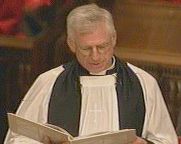 However, the most constant voice remains Senator Father John Claggett "Jack" Danforth, the honorary co-chair of the Missouri Coalition for Lifesaving Cures. His rumbling delivery, folksy, yet polished by years of speaking as both a politician and an Episcopal priest, encourages everyone who is "pro-life" to join him in supporting the amendment. While a recent spot engages in a bit of "negative campaigning" — wherein he chastizes those who dare to speak against Amendment 2 — Danforth has mainly stuck to the mantra that Two is good, life-promoting, and anti-cloning.
However, the most constant voice remains Senator Father John Claggett "Jack" Danforth, the honorary co-chair of the Missouri Coalition for Lifesaving Cures. His rumbling delivery, folksy, yet polished by years of speaking as both a politician and an Episcopal priest, encourages everyone who is "pro-life" to join him in supporting the amendment. While a recent spot engages in a bit of "negative campaigning" — wherein he chastizes those who dare to speak against Amendment 2 — Danforth has mainly stuck to the mantra that Two is good, life-promoting, and anti-cloning.Meanwhile, the Missouri Roundtable for Life provides A Word-By-Word Critique Of The So-Called “Missouri Stem Cell Research And Cures Initiative”. Missourians Against Human Cloning and the related 2Tricky.org also engage in extended political and legal criticism of Amendment 2.
In the religious arena, the opposition also continues. Among Lutherans, the November online edition of the Reporter Online from the LCMS includes commentary devoted to clearing the confusion surrounding stem cell research. This followed President Kieshnick's letter from earlier this week and the excellent 2005 report of Synod's CTCR, Christian Faith and Human Beginnings: Christian Care and Pre-Implantation Human Life [PDF; 187kb, 52 pages], as well as other articles and position papers. Likewise, the Wisconsin Synod has spoken on the topic on several occasions.
Lutherans for Life includes a special page devoted to the Missouri Stem Cell Research and Cures Initiative with items for download (The "Deceitful Tongue" of the Missouri Stem Cell Research and Cures Initiative) and purchase (inexpensive and easily understood pamphlets on stem cells and cloning). Individual Lutherans are also mobilizing and responding. Among these, we note blogging Pastor Walter Snyder and his recent article Stem Cells and Clones.
Known for its long-standing pro-life positions, the Roman Catholic Church, especially Missouri's bishops, is also working against adoption of the amendment. Other churches opposing or harboring strong reservations concerning ESCR include the Greek Orthodox Archdiocese of America and the Southern Baptist Convention. Non-church religious organizations against the amendment and ESCR include Concerned Women for America, the Christian Coalition, and Focus on the Family.
Some might also be persuaded by those who focus on the ethical components of life-issue debates without emphasizing any particular religious affiliation. Among these, the Vitae Caring Foundation stands out. They've launched a special page dedicated to the debate: Stem Cell Research Facts — a site I highly recommend for its gentle tone and low-jargon explanations of the issues.
 Contrary to what you will read from the above groups and individuals, we have the voices of the Missouri Coalition for Lifesaving Cures, particularly that of Senator Danforth. On one of his television spots, he flatly says that Amendment 2 "bans human cloning" — a statement in line with what the coalition and the Amendment seem to say. However, if you carefully read the text of Amendment 2 and compare it to some of the opponents' writings, you'll see that what the amendment actually does is redefine cloning to exclude the somatic cell nuclear transfer (SCNT) process. This is, by the way, the method used to clone the famous Dolly the Sheep.
Contrary to what you will read from the above groups and individuals, we have the voices of the Missouri Coalition for Lifesaving Cures, particularly that of Senator Danforth. On one of his television spots, he flatly says that Amendment 2 "bans human cloning" — a statement in line with what the coalition and the Amendment seem to say. However, if you carefully read the text of Amendment 2 and compare it to some of the opponents' writings, you'll see that what the amendment actually does is redefine cloning to exclude the somatic cell nuclear transfer (SCNT) process. This is, by the way, the method used to clone the famous Dolly the Sheep.With masterful double-speak, amendment supporters say that unless "cloned" material is actually implanted in a human uterus, "cloning" hasn't actually occurred. At best, the Missouri Coalition and Senator Danforth have adjusted the facts to fit their case. At worst, they're flat-out lying. The actual text of Amendment 2 [PDF] includes the following language. From section 2(1), we read, "No person may clone or attempt to clone a human being." Section 6(2) then says, "'Clone or attempt to clone a human being' means to implant in a uterus or attempt to implant in a uterus anything other than the product of fertilization of an egg of a human female by a sperm of a human male for the purpose of initiating a pregnancy that could result in the creation of a human fetus, or the birth of a human being."
This all sounds good, but then we stumble across the references to SCNT. Section 6(5) says, "'Human embryonic stem cell research,' also referred to as 'early stem cell research,' means any scientific or medical research involving human stem cells derived from in vitro fertilization blastocysts or from somatic cell nuclear transfer. [emphasis added]" 6(13) adds this definition: "'Stem cell' means a cell that can divide multiple times and give rise to specialized cells in the body, and includes but is not limited to the stem cells generally referred to as (i) adult stem cells that are found in some body tissues (including but not limited to adult stem cells derived from adult body tissues and from discarded umbilical cords and placentas), and (ii) embryonic stem cells (including but not limited to stem cells derived from in vitro fertilization blastocysts and from cell reprogramming techniques such as somatic cell nuclear transfer). [emphasis added]"
So the amendment says that it will constituionally ban uterine implantation of bio-material created through SCNT. Yet the process of SCNT is absolutely necessary to carrying out the research called for by the amendment. And while the Missouri Coalition says that SCNT isn't cloning, the religious and political sites I've already noted say that it is.
 Now before you accuse this Aardvark of showing his own biases and basing all his arguments upon the testimony of friendly witnesses, let's call one more organization to testify. Indeed, this may be the most unbiased witness in the entire debate, since no one is going to accuse the National Institutes of Health of being a right-wing, conservative Christian, pro-life organization. Therefore, when the NIH Glossary of Stem Cell Information mentions somatic cells and SCNT, both sides should give serious credence to their definition: "Somatic cell nuclear transfer (SCNT)—A technique that combines an enucleated egg (nucleus removed) and the nucleus of a somatic cell to make an embryo. SCNT is the scientific term for cloning. SCNT can be used for therapeutic or reproductive purposes, but the initial stage that combines an enucleated egg and a somatic cell nucleus is the same. See also therapeutic cloning and reproductive cloning. [emphasis added]"
Now before you accuse this Aardvark of showing his own biases and basing all his arguments upon the testimony of friendly witnesses, let's call one more organization to testify. Indeed, this may be the most unbiased witness in the entire debate, since no one is going to accuse the National Institutes of Health of being a right-wing, conservative Christian, pro-life organization. Therefore, when the NIH Glossary of Stem Cell Information mentions somatic cells and SCNT, both sides should give serious credence to their definition: "Somatic cell nuclear transfer (SCNT)—A technique that combines an enucleated egg (nucleus removed) and the nucleus of a somatic cell to make an embryo. SCNT is the scientific term for cloning. SCNT can be used for therapeutic or reproductive purposes, but the initial stage that combines an enucleated egg and a somatic cell nucleus is the same. See also therapeutic cloning and reproductive cloning. [emphasis added]"The American Heritage Dictionary, cited in Pastor Snyder's article says a clone is "A cell, group of cells, or organism that are descended from and genetically identical to a single common ancestor." The NIH says, "SCNT is the scientific term for cloning." Senator Danforth and the Missouri Coalition for Lifesaving Cures say that SCNT is not cloning and ignore the fact that the materials to be produced and studied will be "descended from and genetically identical to" the common ancestors from which the somatic cells will be taken.
So who knows "Jack" about stem cells and cloning? Either the LCMS, the WELS, Lutherans for Life, the Roman Catholic Church, the Greek Orthodox Archdiocese, the Southern Baptist Convention, Missourians Against Human Cloning, the Missouri Roundtable for Life, Americans to Ban Cloning, Concerned Women for America, Focus on the Family, Do No Harm: The Coalition of Americans for Research Ethics, the Vitae Caring Foundation, the Christian Coalition, National Right to Life, Ask the Pastor, and the United States' own National Institutes of Health are all wrong about human cloning or else we must disbelieve the words and the motives of Senator Danforth, the Missouri Coalition for Lifesaving Cures, and the proposed Missouri Amendment 2. Whom do you believe? Which side do you think is lying to you?
With all this, we've only scratched the surface of possible arguments. Other objections parallel those that many people raise to abortion. In other words, if you believe that life begins at conception, then you must reject not only abortion, but much of Danforth's repetitive message. He claims, "My entire political career, I voted pro-life and that is exactly why I favor the Stem Cell Initiative. I believe in saving human life. [current radio ad]" Yet the ESCR called for by Amendment 2 — featuring tiny little embryos (or "blastocysts," if you will) of growing, developing human cells — will halt cell division (kill tiny little unborns) in the name of saving human beings fortunate enough to have emerged from their mothers' wombs.
Pro-ESCR people often ask us Christians how we can be truly pro-life and not support embryonic stem cell research and its possiblities of providing cures for diseases and injuries. We, in turn, must ask them how they can claim to be truly pro-life while arguing for the creation and destruction of human beings. Jesus said, "Greater love has no one than this, that someone lays down his life for his friends. [John 15:13 ESV]" These unborn, embryonic people cannot volunteer themselves on behalf of others. What sort of twisted "love" for humanity chooses without the consent of the "chosen" which lives to sacrifice in order save others?

The memo referred to in President Kieschnick's letter (above) concludes as follows: "The Declaration of Independence of the USA recognizes the right of every living human being to life. When the state forfeits its God-given responsibility to protect and defend the life of any of us, the life of each of us is endangered. We in The Lutheran Church — Missouri Synod are therefore eager to join together with American citizens of all faiths in opposing any amendment to the Constitution of the State of Missouri or any other state which would legalize the killing of individual human beings from the time of conception to natural death."
I haven't changed my mind since I wrote last December about Jack Danforth's support of the then-pending amendment. I ended that post with these words: "To borrow from Pink Floyd, 'Hey, Danforth, leave them kids alone!' Keep your mellifluous speeches, your melodious words, your malodorous theology, and your malevolent philosophy off the airwaves. Either that, or tell the straight truth: You favor growing and killing babies to treat the illnesses and injuries of those old enough to vote and rich enough to support liars like you and the Missouri Stem Cell Research and Cures Initiative."
Technorati Tags: embryonic stem cells | cloning | pro-life | Missouri | Amendment 2 | Lutheran | Christian | Embryonic Stem Cell Research | ESCR | Somatic Cell Nuclear Transfer | SCNT | John Danforth | Jack Danforth | religion | politics
Missourians Against Human Cloning have provided a number of TV spots and videos, including this one posted at YouTube:
Technorati Tags: embryonic stem cells | cloning | pro-life | Missouri | Amendment 2 | Lutheran | Christian | Missourians Against Human Cloning | video | YouTube
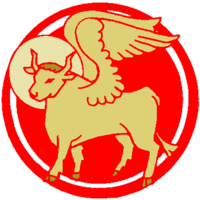 Saint Luke the Evangelist was a physician (Colossians 4:14) and a companion of St. Paul on some of his missionary journeys (see Acts 16:10ff; 20:5ff; 27-28).
Saint Luke the Evangelist was a physician (Colossians 4:14) and a companion of St. Paul on some of his missionary journeys (see Acts 16:10ff; 20:5ff; 27-28).Material found in his Gospel and not elsewhere includes much of the account of Jesus's birth, infancy, and boyhood. He recounts some of the most moving parables, including the Good Samaritan and the Prodigal Son. He also provides three of the sayings of Christ on the Cross: "Father, forgive them, (23:34)" "Today, you will be with me in Paradise, (23:43)" and "Father, into your hands I commit my spirit! (23:46)"
Luke's Gospel account emphasizes the human love of Christ, His compassion for sinners and for suffering and unhappy persons, for outcasts such as the Samaritans, tax collectors, lepers, shepherds (not a respected profession), and for the poor. The role of women in Christ's ministry is more emphasized in Luke than in the other Gospel writings.
Much of Christianity uses each of the four living creatures (see Ezekiel 1 and Revelation 4) as a symbol one of the four evangelists. While attributions vary in parts of Christendom, most of the Western Church assigns the winged ox to Saint Luke. The association probably comes because the ox was one of the major sacrificial animals under the Old Covenant while Luke strongly highlighted the sacrifical elements of Christ's life, suffering, and death.
Lection
Psalm 138 or 147:1-7
Isaiah 43:8-13 or 35:5-8
2 Timothy 4:5-11
Luke 1:1-4, 24:44-53 or 10:1-9
Collect
Almighty God, whose blessed Son called Saint Luke the physician to be an evangelist and physician of the soul, grant that the healing medicine of Your Word and the Sacraments may put to flight the diseases of our souls that with willing hearts we may ever love and serve You; through Jesus Christ, Your Son, our Lord, who lives and reigns with You and the Holy Spirit, one God, now and forever.
Scripture quoted from The Holy Bible, English Standard Version™, © 2001 by Crossway Bibles.
Technorati Tags: Saint Luke the Evangelist | Saint Luke | Gospel | Luke | St. Luke | Saint Paul | winged ox | biblical history | four living creatures
Many and varied are the ways in which religion — specifically, the biblical Christianity of confessional Lutheranism — intersects with politics and science. Sometimes the relationships are somewhat cordial, at others, sharp differences and heated disagreements are the norm. The upcoming election provides for the latter, as Pastor Walter Snyder demonstrates in Stem Cells and Clones: What's the Matter with Missouri Amendment 2? at the Ask the Pastor blog. For those interested in learning more or in becoming more politically active before the elections, he includes links to references and supporting materials.
Technorati Tags: embryonic stem cells | cloning | pro-life | Missouri | Amendment 2 | Lutheran | Christian | Ask the Pastor
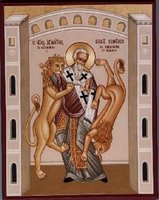 St. Ignatius, Pastor and Martyr, was the bishop of Antioch in Syria at the beginning of the second century AD and an early Christian martyr. Near the end of the reign of the Roman emperor Trajan (98-117), Ignatius was arrested, taken in chains to Rome, and eventually thrown to the wild beasts in the arena.
St. Ignatius, Pastor and Martyr, was the bishop of Antioch in Syria at the beginning of the second century AD and an early Christian martyr. Near the end of the reign of the Roman emperor Trajan (98-117), Ignatius was arrested, taken in chains to Rome, and eventually thrown to the wild beasts in the arena.On the way to Rome, he wrote letters to the Christians at Ephesus, Magnesia, Tralles, Rome, Philadelphia, and Smyrna, and also to Polycarp, bishop of Smyrna. In the letters, which are beautifully pastoral in tone, Ignatius warned against certain heresies (false teachings). He also repeatedly stressed the full humanity and deity of Christ, the reality of Christ's bodily presence in the Lord's Supper, the supreme authority of the bishop, and the unity of the Church found in her bishops.
Ignatius was the first to use the word catholic to describe the universality of the Church. His Christ-centeredness, his courage in the face of martyrdom, and his zeal for the truth over against false doctrine remain his lasting legacy to the Church.
Lection
Psalm 116:1-8 or 31:1-5
Romans 8:35-39
John 12:23-26
Collect
Almighty God, we praise you for your bishop and martyr Ignatius of Antioch, who offered himself as grain to be ground by the teeth of wild beasts that he might present to you the pure bread of sacrifice. Accept the willing tribute of our lives, and give us a share in the pure and spotless offering of your Son Jesus Christ; who lives and reigns with you and the Holy Spirit, one God, now and forever.
Technorati Tags: Saint Ignatius of Antioch | Saint Ignatius | Ignatius of Antioch | Trajan | Polycarp | martyr | martyrdom | church history | historical theology
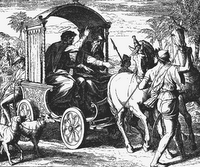 The deacon Philip, was also called an evangelist (see Acts 21:8). He was one of the seven men appointed to assist in the work of the twelve Apostles and of the rapidly growing early church by overseeing the distribution of food to the poor, especially to the widows who had limited support (6:1-6).
The deacon Philip, was also called an evangelist (see Acts 21:8). He was one of the seven men appointed to assist in the work of the twelve Apostles and of the rapidly growing early church by overseeing the distribution of food to the poor, especially to the widows who had limited support (6:1-6).Unless Saint Luke omitted some portion of the selection process, this Philip is not the Philip we meet in the Gospels. And if they are the same person, we are given no reason why one of the Apostles would separate himself from the particular ministry into which Christ had called him. Therefore, we are most likely dealing with two separate Philips in the New Testament.
Following the martyrdom of Stephen, Philip proclaimed the Gospel in Samaria and led Simon the Sorcerer to become a believer in Christ (8:4-13). He was also instrumental in bringing about the conversion of the Ethiopian eunuch (8:26-39), through whom Philip became indirectly responsible for bringing the Good News of Jesus to the people on the continent of Africa.
We must also make two historical asides. First, the "Ethiopia" known to the Mediterranian world of Philip's time may actually have been part of modern-day Sudan. Second, while a "eunuch" is technically a castrated male, it also served at times as a generic term for royal officials, including some where records indicate that they were capable of siring children.
Saint Philip's final appearance in Scripture comes in conjunction with Saint Paul. He hosted the apostle in the town of Caesarea before the apostle completed his final visit to Jerusalem (21:8-15).
Collect
Almighty and everlasting God, we thank you for your servant Philip the Deacon, whom you called to proclaim the Gospel to the peoples of Samaria and Ethiopia. Raise up in this and every land heralds and evangelists of your kingdom, that your Church may make known the immeasurable riches of our Saviour Jesus Christ, who lives and reigns with you and the Holy Spirit, one God, now and forever.
Technorati Tags: Philip the Deacon | Philip the Evangelist | Saint Philip | Ethiopian eunuch | evangelism | baptism | church history
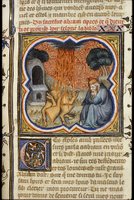 The Lord called the Patriarch Abraham (first known as Abram) to become the father of a great nation (Genesis 12). At age 75, in obedience to God's command, he, his wife Sarai (later Sarah), and his nephew Lot moved southwest from the town of Haran to the land of Canaan. There, the Lord cut a covenant with Abram (Genesis 15), promising the land of Canaan to his descendants. In Genesis 17:1-16, the Lord established circumcision as a sign of His covenant people while also renaming Abram as Abraham and Sarai as Sarah.
The Lord called the Patriarch Abraham (first known as Abram) to become the father of a great nation (Genesis 12). At age 75, in obedience to God's command, he, his wife Sarai (later Sarah), and his nephew Lot moved southwest from the town of Haran to the land of Canaan. There, the Lord cut a covenant with Abram (Genesis 15), promising the land of Canaan to his descendants. In Genesis 17:1-16, the Lord established circumcision as a sign of His covenant people while also renaming Abram as Abraham and Sarai as Sarah.At the age of 100 Abraham and Sarah were finally blessed with Isaac, the son long promised to them by God. Abraham demonstrated supreme obedience when God commanded him to offer Isaac as a burnt offering. God spared the young man's life only at the last moment and provided a ram as a substitute offering (22:1-19). Abraham died at the age of 175 and was buried in the Cave of Machpelah, which he had purchased earlier as a burial site for Sarah. He is especially honored as the first of the three great Old Testament Patriarchs — and for his "righteousness before God through faith. (Romans 4:1-12)"
 In the great "Faith Chapter" of Hebrews 11, Abraham holds a prominent place. The writer noted several instances where Abraham acted "by faith," contrary to worldly evidence but in accordance with God's will. "By faith," he "obeyed when he was called to go out to a place that he was to receive as an inheritance (v. 8)"; he "went to live in the land of promise ... with Isaac and Jacob (v. 9)"; and he, "when he was tested, offered up Isaac. (v. 17)" Likewise, among the others listed, God also commended the faith of Sarah, Isaac, and Jacob through the writer of Hebrews.
In the great "Faith Chapter" of Hebrews 11, Abraham holds a prominent place. The writer noted several instances where Abraham acted "by faith," contrary to worldly evidence but in accordance with God's will. "By faith," he "obeyed when he was called to go out to a place that he was to receive as an inheritance (v. 8)"; he "went to live in the land of promise ... with Isaac and Jacob (v. 9)"; and he, "when he was tested, offered up Isaac. (v. 17)" Likewise, among the others listed, God also commended the faith of Sarah, Isaac, and Jacob through the writer of Hebrews.The promised blessing of the nations came to fruition in the person of Jesus Christ. He was a son of Abraham by blood, by circumcision, and by His relationship with our heavenly Father. While the Jews traced their descent from Abraham according to his bloodlines, Christians are listed in Scripture as Abraham's true children by faith in Christ. Paul wrote that Abraham is "the father of us all" who share his faith in God (Romans 4:16). In Galatians, Paul also wrote, "Know then that it is those of faith who are the sons of Abraham. And the Scripture, foreseeing that God would justify the Gentiles by faith, preached the gospel beforehand to Abraham, saying, 'In you shall all the nations be blessed.' So then, those who are of faith are blessed along with Abraham, the man of faith. (3:7-9)"
Technorati Tags: Abraham | Abram | Sarah | Sarai | Isaac | Jacob | covenant | Jesus | Jesus Christ | Christ | Messianic prophecy | sacrifice | prophecy | Scripture | Bible | Old Testament | Bible history | Church Year | liturgical calendar | Christianity | Christian | Lutheran | Lutheranism | confessional Lutheran | Christian feasts | biography | hagiography | saint | commemorations | lectionary | exegetical theology
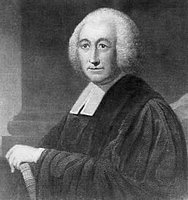 Moving from the Old World to the New, H. M. Muhlenberg established the shape of Lutheran parishes and Lutheranism in general in America during a 45-year ministry in Pennsylvania. Born at Einbeck, Germany, in 1711 and baptized Heinrich Melchior Mühlenberg, he came to the American colonies in 1742.
Moving from the Old World to the New, H. M. Muhlenberg established the shape of Lutheran parishes and Lutheranism in general in America during a 45-year ministry in Pennsylvania. Born at Einbeck, Germany, in 1711 and baptized Heinrich Melchior Mühlenberg, he came to the American colonies in 1742.A tireless traveler, Muhlenberg helped to found many Lutheran congregations and was the guiding force behind the first American Lutheran synod, the Ministerium of Pennsylvania, established in 1748. He valued the role of music in Lutheran worship (often serving as his own organist) and was also largely responsible for preparing the first American Lutheran liturgy (also in 1748).
We remember Muhlenberg as church leader, journalist, liturgist, and — above all — as faithful pastor to those in his charge. He died in 1787, leaving behind a large extended family and a lasting heritage: American Lutheranism.
Collect
Heavenly Father, Shepherd of Your people, we thank You for Your servant Henry Melchior Muhlenberg, who was faithful in the care and nurture of Your flock, and we pray that, following his example and the teaching of his holy life, we may by Your grace grow into the stature of the fullness of our Lord and Savior Jesus Christ; who lives and reigns with You and the Holy Spirit, one God, now and forever.
Technorati Tags: Henry Melchior Muhlenberg | H. M. Muhlenberg | Lutheranism | Pennsylvania Ministerium | Lutheran | America | United States | American history | church history
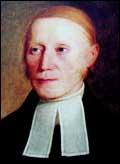 The early Church entrusted some women, particularly widows, with helping to carry out the "social work" of the Church, particularly caring for the sick and needy of the congregation. From reading 1 Timothy 5:1-16, it appears that certain of these women were specially consecrated and made a lifetime commitment to works of mercy. The idea of a female deaconate or service order largely died out by the 7th Century AD, although some groups of nuns and a few informally organized groups undertook similar work.
The early Church entrusted some women, particularly widows, with helping to carry out the "social work" of the Church, particularly caring for the sick and needy of the congregation. From reading 1 Timothy 5:1-16, it appears that certain of these women were specially consecrated and made a lifetime commitment to works of mercy. The idea of a female deaconate or service order largely died out by the 7th Century AD, although some groups of nuns and a few informally organized groups undertook similar work.The modern deaconess movement came mainly through the work of Theodor Fliedner, a German Lutheran. Born in Eppstein, Germany, in 1800, he became pastor of a small parish in Kaiserswerth in 1821 or 1822. Fliedner took the work of England's Elizabeth Fry and Dutch Mennonites as inspiration. Encountering Moravian deaconesses, he also drew from their example.
He began serving the Düsseldorf Prison, walking to and from Düsseldorf on alternating Sundays until the appointment of a regular prison chaplain. This led to more prisons engaging chaplains and establishing regular worship and aid services for the prisoners. He envisioned and opened a nursery school; eventually it became a sort of teachers' college and a starting point for what would become his first deaconess school.
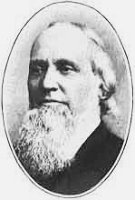 Becoming more involved in Christian social work among the disadvantaged, Fliedner convinced himself that he should revive the order of deaconesses. He opened a hospital and deaconess training center in Kaiserswerth on 13 October 1836. Florence Nightingale heard of his reputation, visited the school in the 1840s, came back to study nursing, and graduated in 1851.
Becoming more involved in Christian social work among the disadvantaged, Fliedner convinced himself that he should revive the order of deaconesses. He opened a hospital and deaconess training center in Kaiserswerth on 13 October 1836. Florence Nightingale heard of his reputation, visited the school in the 1840s, came back to study nursing, and graduated in 1851.The program was so successful that he could send deaconesses to other hospitals by 1838. New deaconess motherhouses grew up in Pittsburgh, Pennsylvania and in Jerusalem, Paris, Berlin, and Strasbourg, and elsewhere. When he died, 30 motherhouses already stood and over 1500 deaconesses served around the world. The middle of the 20th century saw more than 35,000 deaconesses serving world-wide.
Lutherans in the United States may also want to remember William Passavant, who pioneered the American deaconess movement in 1849. He also founded missions, hospitals, orphanages, and schools. Passavant died 3 January 1894.
Additional information available from Wikipedia and James Kiefer.
Posted in special honor of my dear Ste. Em.
Technorati Tags: Theodor Fliedner | Theodore Fliedner | William Passavant | deaconesses | nursing | hospitals | Florence Nightingale | Lutheran | church history

